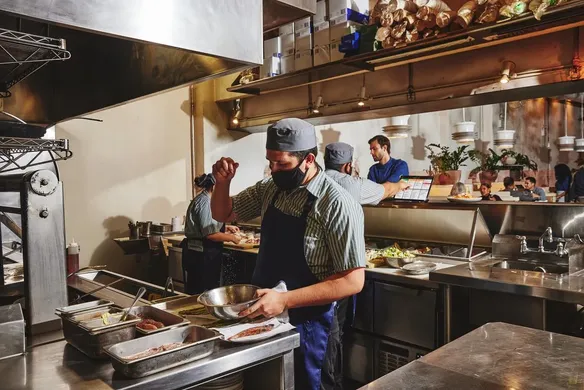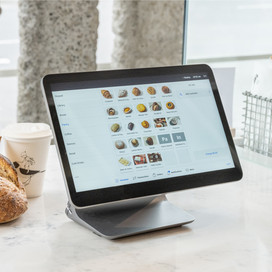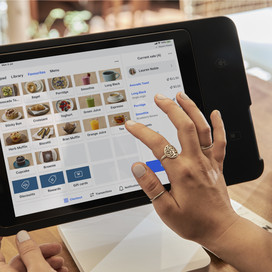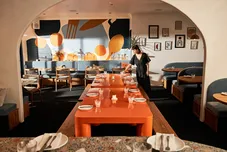Table of contents
If you’ve got a love for pizza, with pineapple of course, opening your own restaurant might sound like a tasty prospect. As an always in-demand food choice with potentially lower overheads and minimal waste, pizzerias can certainly prove a profitable venture for savvy business owners.
Below, we’ve run through some of the key considerations you’ll need to think about when starting a pizza business. These include what you’ll need to know before you open your doors, marketing tips for your pizza restaurant and the steps you’ll need to take to get the appropriate licensing and approvals.
What are the benefits of owning a pizza shop?
Pizza is an incredibly popular food that is unlikely to ever go out of fashion – so you’ll always have a strong base of potential customers.
Running a pizza restaurant can be a profitable business because the ingredients you need to make pizza can be relatively low-cost and you can create an extensive menu with very few ingredients. Get creative!
There’s also less wastage in the pizza business than in many other types of restaurants. This is due to food being made to order and lots of the ingredients having a long shelf-life.
Example pizza business models
Below are some examples of pizza restaurant business models in Australia.
Full-service pizzeria
A full-service pizzeria runs like a regular restaurant. It will have a relatively broad menu, enough tables to seat customers, table service and wait staff. The main focus of a full-service model is eat-in diners, although it may also offer food for takeaway and delivery.
Takeaway and delivery pizza
If you decide to focus on providing takeaway and delivery pizza, you might want to set up a small shop as your base, so customers can drop by to pick up their pizza themselves as well as have it delivered.
Mobile catering or food truck pizzeria
As a mobile catering pizzeria, much of your business would likely come from booking events. Clients might hire you to cater for a wedding, a festival or a large corporate event, for example. Bear in mind that you may need to get special licenses and permits if you decide to go down this route.
Pop-up pizzeria
Pizza pop-ups are temporary restaurants that serve pizza for a limited time only. Even though each pop-up location is temporary, this could be a year-round business if you’re constantly moving your pop-up into different areas.
Ghost kitchen pizzeria
Ghost kitchens started to become popular during the pandemic. A ghost kitchen pizzeria does not have a physical store that customers can visit. Food is only available through online ordering and delivery.
How to start a pizza business: what you’ll need to know
There are a few essential things you’ll need to consider before you can get started with your pizza restaurant.
Industry knowledge and practical skills
If you haven’t already worked in or managed restaurants, you could consider gaining a bit of experience before you set up your pizza shop or taking a course to run you through everything you’ll need to know.
It’s also worth hiring people who have experience in the industry and are familiar with all its quirks – whether that’s chefs and wait staff, or accountants and lawyers.
Research your market
Before you open your pizzeria, you’ll need to research your market. Take a look at your local competitors and check:
- the price of their pizzas
- the range of their menus, and what they offer besides pizza
- their opening hours
- delivery information
This should help you figure out how you’re going to run your restaurant. Is there more of a gap in the market for gourmet-style pizza or a cheap 24-hour pizza-by-the-slice outlet, for example?
Make a business plan
Once you’ve got an idea of the type of pizza restaurant you want to run, you’ll need to make a business plan before making any firm commitments such as signing any leases.
To get you started, here are some key elements that your business plan for a pizza shop should cover:
- A branded cover page and executive summary of your plan
- The concept for your business
- A sample menu
- Analysis of the market and your target market, detailing why your restaurant will appeal to them
- Where the pizza shop will be located and what it will look like – there should be a clear link to your target market here
- Market overview – this will include information about the local economic conditions, as well as detailing the relevant licenses or permits that your restaurant will need
- How service will work at your restaurant
- What your marketing and implementation strategy will be
- A summary of the management team – this should include a brief overview of everyone on the team’s relevant experience
- Details of any outside consultants you plan on working with, such as architects, accountants, lawyers and PR specialists.
- Your financial plans and projections – if you’re using an accountant they should be able to help you write this section
Your menu will probably tie in closely with your restaurant’s concept. Whatever concept you decide to go for, it’s always a good idea to include a couple of classic choices such as a Margherita or Aussie pizza.
Once you’ve finalised your menu, you’ll be able to start work on your branding and design.
Make sure you have the right tech
Keep the day-to-day running of your pizza restaurant as smooth and seamless as possible with an all-in-one point-of-sale system (POS).
Square’s POS covers everything you’ll need, from bookings, staff and menu management to online ordering, payment processing and delivery — we even have specific software for restaurants.
Licenses, registration and permits
As the service of food and alcohol is regulated according to the state in Australia, the licence you need will depend on where your business is located.
In general terms, however, these are the steps you’ll need to follow to get your pizza restaurant registered and licensed:
- Contact your local council to find out what your food business classification is – this will determine what kind of licence you need and how much it will cost
- Register your business, pay any fees and fill out the relevant paperwork with your local council
- Receive a licence to serve food from your state authority
- Register an Australian Business Number, and Australian Company Number with the Australian Securities and Investments Commission
- You’ll need to register for the Goods and Services Tax if your business has a turnover exceeding $75,000
- Get a liquor licence from your local authority if you’re planning to sell alcohol
- Obtain any other licences you might need for your area – for example, in New South Wales, if you want to give your diners the option of eating al fresco you’ll need to obtain a certificate of approval for outdoor dining in a public place
- Put a Food Safety Program in place, and show proof to your local authority
- Either hire or train a Food Safety Supervisor
Getting your pizza restaurant registered with the local council
In Australia, each state and territory has different classifications for food businesses. In order to get licensed, you’ll need to figure out your food business classification from the relevant website for your area. You can find more details and links below.
New South Wales
Cafés, restaurants and similar retail food outlets need to notify the local council of their business and food activity details. You can find your local council here.
Visit the New South Wales food authority website for more detail about food safety controls and inspections.
Australian Capital Territory
ACT food businesses need to register with the Health Protection Service before opening. You can do this by completing the Access Canberra Food Business New Registration Application Form or the Food Business Registration Application.
You can find more information, including registration fees and risk classifications on the ACT.gov website here.
Victoria
If you’re going to be operating in Victoria, you’ll need to get registered by your local council. Your council will then let you know:
- Your registration requirements and any fees you have to pay
- Your food business class (1, 2, 3A, 3 or 4)
- If you are required to have a food safety program and a food safety supervisor
Find out more about starting a food business in Victoria here.
Queensland
You’ll need to apply for a food business licence from your local council in Queensland. Your council will be able to share details of how to apply and any fees you’ll need to pay.
Read more on the Queensland.gov website here.
South Australia
In South Australia, you can contact your local council’s Environmental Health Officers to confirm what requirements your business needs to meet, before notifying the council of your business. Most councils will have a copy of the Food Business Notification form on their website.
The government website for South Australia has more details.
Western Australia
To register your pizzeria in Western Australia, the first step you’ll need to take is to contact the relevant local government Environmental Health Services for details of the local council’s registration process and any other food safety requirements. They’ll send you a registration form to fill out and let you know how much you need to pay.
Read more about how to open a pizza shop in Western Australia here.
Northern Territory
This is the initial form you’ll need to fill out to register your restaurant in the Northern Territory. There are a few things you’ll need to have to hand when you’re filling out this form:
- Your business details (including your Australian Business Number)
- Your contact information
- If your business uses a private water supply, you’ll need your microbiological and chemical water testing results
- A copy of your proposed menu
- Your restaurant’s floor plans, including fixtures and fittings and equipment
Tasmania
Anyone opening a restaurant in Tasmania needs to notify their local council and register their business. If this is your first time registering a food business, an Environmental Health Officer might inspect your premises before issuing a Certificate of Registration of a Food Business. You’ll need the certificate before you can open your doors for business.
Find out more about food safety regulations in Tasmania here.
What insurance will you need for your pizza shop business?
Here are a few types of insurance you might want to consider taking out.
Public liability insurance
This will protect you from having to pay out damages if any of your customers or visitors are injured from slips, falls or breakages on your premises.
It will cover you for:
- Compensation to third parties for injury or death at your business
- Compensation to third parties for loss or damage to their property as a result of your business
- Any related costs of defending your claim, such as legal fees
However, bear in mind that public liability insurance does not also cover employees – you’ll need to take out a workers’ compensation policy to cover staff.
Workers’ compensation insurance
Workers’ compensation insurance is compulsory in Australia if you have employees. The rules around how you provide this cover vary depending on the state or territory, so check requirements with your local authority.
Buildings insurance
This a policy that you’d only need to take out if you actually own the building your restaurant is in. Buildings insurance would pay for repairs or rebuilding costs if your restaurant is damaged or destroyed because of an insurable event, such as a fire or a storm.
Contents cover
You could take out insurance to cover the equipment you need to keep your restaurant running – tables, chairs, pizza ovens and even ingredients.
Business interruption insurance
This kind of cover is only available if you already have either building or contents insurance. It’s designed to help out by providing you with income if your restaurant ever has to close because of an insurable event, such as a fire.
Deterioration of stock cover
This will cover your business if your fridge or freezer breaks down, causing your stock to rot and become unusable.
Essential equipment needed to start a pizza shop business
The exact equipment that you need will vary depending on the type of pizza restaurant you’ve decided to run – but to get you started, here are a few helpful suggestions.
Cooking equipment
- Pizza ovens – when you’re choosing your pizza oven, think about what capacity you’ll need to make enough pizzas to turn a profit.
- Dough mixer – you’ll need this if you’re planning to make your own pizza bases in your shop. Make sure you choose a mixer that can handle the required dough type, weight and quantity.
- Fridges – pick fridges that can hold enough ingredients, and keep them at the right temperature.
- Utensils and accessories – these could include things such as pizza cutters, pizza knives and pizza trays.
Technology
- A POS – using a POS that can handle all aspects of managing your pizza restaurant will make its day-to-day running a lot easier. [Square for restaurants[(https://squareup.com/au/en/point-of-sale/restaurants) has an all-in-one POS that allows you to manage rotas and table bookings, as well as take online orders and process payment. You can also get all the hardware you need to run your POS from Square.
- A kitchen display system (KDS) – reduce the risk of missing orders with Square’s KDS. It allows you to view, track, and fulfil orders via digital tickets in the back of the house, replacing traditional paper tickets and kitchen printers.
How to choose a pizza shop location
The location of your pizza restaurant could end up being key to its success. Here are a few things to consider when you’re scouting for the best place to set up shop:
- Affordability – you’ll want to be confident that you can afford to pay the lease or mortgage every month.
- Demographics of the area – does it hit your target market?
- Visibility and accessibility – will people both know your pizza shop is there and be able to access it easily?
- Size and layout – will you be able to fit all your equipment in and seat enough customers?
Marketing your pizza restaurant business
Once you’ve got your pizza shop up and running, you’ll need to attract customers. Here are a handful of tried and tested ways you could market your restaurant.
- Create a website – having an online presence is a simple way to extend your reach to potential customers. Build an online store quickly and easily with Square.
- Get on social media – encourage your customers to upload and tag you in photos, as well as create your own shareable content to get your brand out there.
- Invest in a professional food photographer – food photography is its own art form so display your pizzas in their most delicious-looking light with some professional photographs that you can use on your social media and other marketing channels.
- Use special offers – you could get creative with some attention-grabbing special offers, such as themed deals around new movie releases or sports events.
How much can you charge customers?
There are two methods you could use for figuring out how much to charge customers for your pizzas. These are either by food cost or by gross profit margin.
Food cost refers to an item’s menu price compared to how much it cost you to prepare the item – so, ingredients and general restaurant costs. The lower the food cost, the higher your profit. On average, most restaurants run a food cost of between 28–35%.
Gross profit margin is the percentage of your total sales that is profit. So, for example, if a side dish of dough balls has a gross profit margin of 30%, that means 30 cents of every dollar you spent to make the dish is profit.
Your pricing will also depend on the type of restaurant you’re running. Customers will naturally expect to pay less at a hole-in-the-wall, pizza-by-the-slice shop than they would for a sit-down meal with drinks at a full-service restaurant.
![]()












